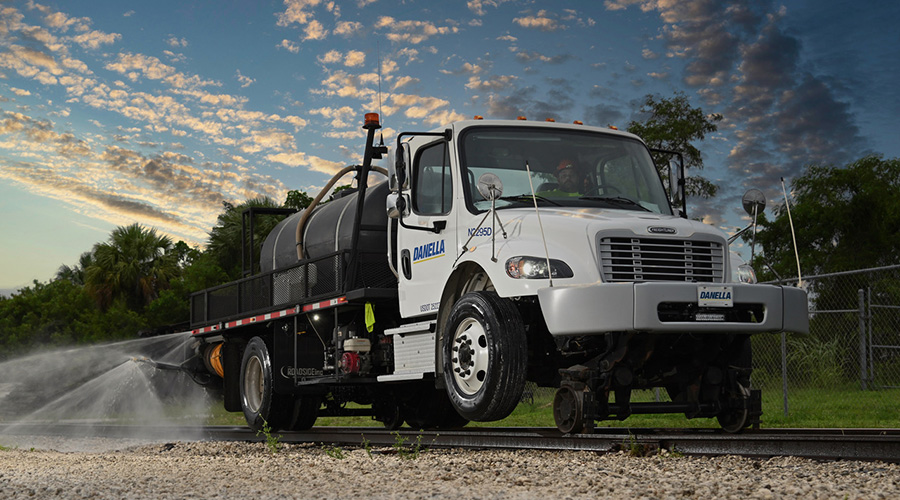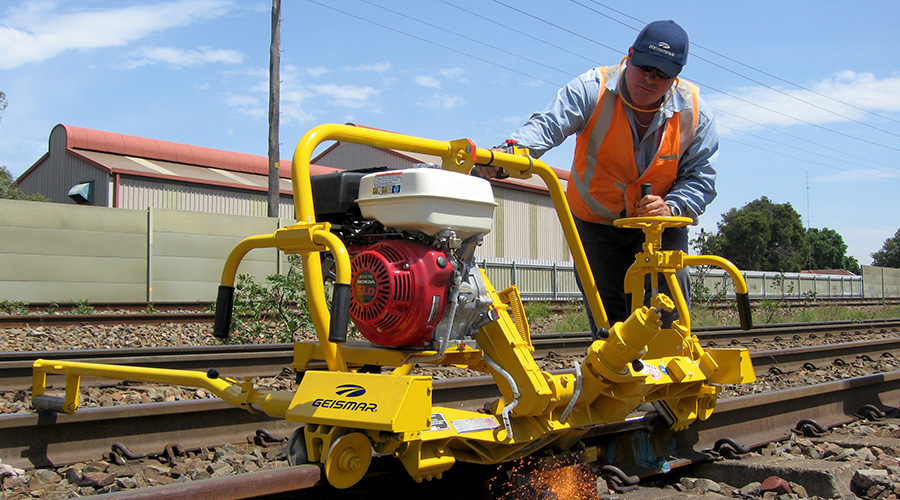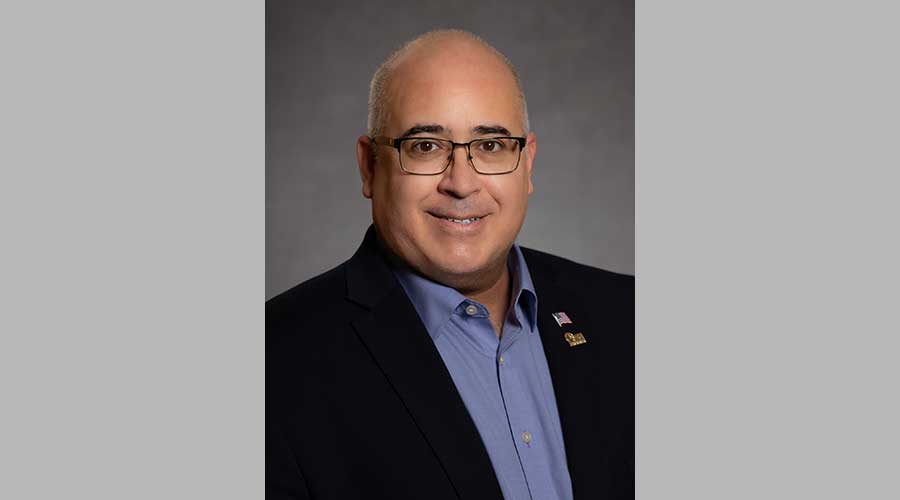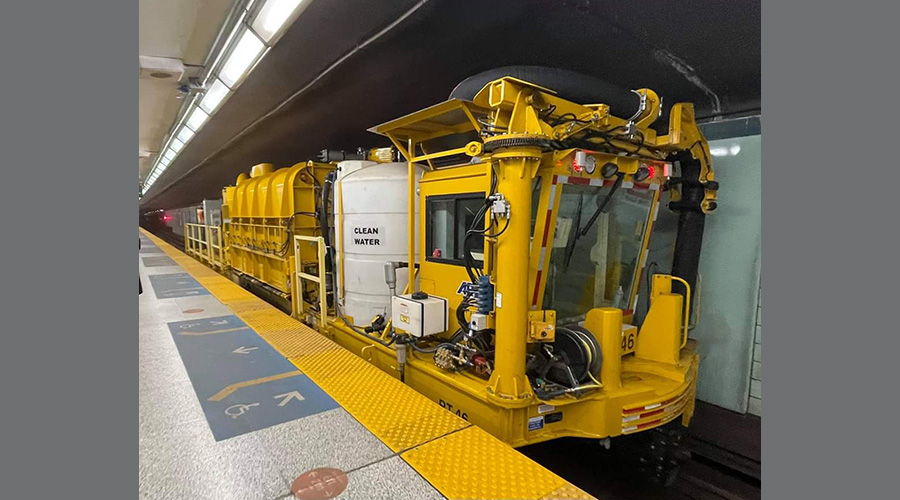Stay updated on news, articles and information for the rail industry
January 2013
Rail News: MOW
Material handling and distribution equipment update
Compiled by Howard Ande
We recently checked in with a cross-section of companies that supply equipment that helps railroads distribute maintenance-of-way (MOW) materials. We asked them to weigh in on what they consider to be emerging trends in the material-handling realm, and to discuss the extent to which those trends are having an impact on technology development. Accordingly, we requested that they share information on recent product introductions. We also wondered what their railroad customers are clamoring for, product or equipment wise. Here's what six of them told us — one in an interview and five via email.
Auto Truck Group
There's more technology in railroad maintenance vehicles these days — from signal construction, bridge maintenance and locomotive service trucks to signal maintainers to material handlers, said Auto Truck Group Director of Railroad Operations Pete Dondlinger.
"We are giving our customers the ability to get chassis and equipment information to see how vehicles are being utilized," he said, adding that Auto Truck Group's customers include Class Is, short-line railroads and contractors. "An example of this is how often you use your crane to help improve maintenance intervals. Hi-rail sensors allow the customer to tell if a vehicle is on road or rail, how fast it is moving and where it is located."
Meanwhile, Class Is now are using only hydraulic railgear, which "eliminates the manual process to raise and lower the gear, and also allows operators get off a crossing quickly," Dondlinger said.
Customers also continue to emphasize product liability, and "more sophisticated systems continue to emerge for engine, truck and crane controls," he added.
One example: air suspension override to fix airbag pressures in crane applications. The driver will have an improved ride quality on the road and a stable lift when operating the crane, Dondlinger said.
"Computer monitoring systems are becoming more sophisticated and reliable to monitor factors such as outrigger position and other functions critical to ensuring crane stability," he added.
Auto Truck Group offers hydraulic loaders with a magnet generator system for lifting tie plates, spikes and other track material. The company also is building trucks for bridge construction and maintenance.
"Some of our equipment can be operated from an elevated operator's seat, which gives better visibility and safety," Dondlinger said. "There have been many technological improvements in radio remote controls, which help as well."
Auto Truck Group is designing specialized vehicles for track, signal, bridge, centenary and other functions. The company also is seeing an increased demand for specialized applications.
"We're seeing demand for highly engineered products with very specific functions for both truck and rail-car mounted applications," Dondlinger said.
Georgetown Rail Equipment Co.
Georgetown Rail Equipment Co.'s (GREX) newest service — BallastSaver — was developed "in response to requests by our customers for an efficient and precise calculation of deficient ballast as an alternate to the cumbersome and less accurate method of a human inspector 'eyeballing' it," said Vice President of Marketing and Sales Lynn Turner in an email.
BallastSaver utilizes Light Detection and Ranging (LIDAR) technology along with cameras to scan the roadbed and generate an accurate measurement of the current ballast profile. This data then is compared with the standard profile furnished by the customer to calculate the amount of deficient ballast along the roadbed. BallastSaver data can be fed directly into GREX's Gatesync software for precise and automated delivery of ballast with GateSync-equipped ballast cars at speeds up to 10 mph. BallastSaver also may be used as a stand-alone tool for maintenance planning and budgetary purposes.
BallastSaver scans generate a report specifying the total cubic feet of material needed per mile to bring the current profile back up to the customer-provided standard profile. A survey of the locations to deliver the ballast and images of the track from still pictures taken by the camera also can be delivered. In addition, the amount of ballast needed to lift the track from its current elevation to a height of choice can be calculated: If a one-inch lift is requested, a calculation is made to determine the quantity of ballast needed to achieve this goal.
BallastSaver was originally designed as an enhancement to GREX's GateSync automated ballast unloading system.
"Previously, ballast requirements were determined largely by a human assessment often dictated by the number of cars loaded with ballast coming from the quarry," Turner said. "This is a very subjective process. It is impossible to visually estimate the amount of deficient ballast which most likely would lead to inefficient distribution of ballast, possibly creating maintenance issues. BallastSaver, in conjunction with GateSync-equipped ballast cars, eliminate the subjectivity of this process allowing for automated delivery of the exact amount of ballast needed to be precisely placed where it is needed."
Recently, GREX began offering BallastSaver to railroad customers as a stand-alone service. Data derived from scans performed by BallastSaver provide the user with information that aids in planning, budgeting, and prioritizing track maintenance and projects.
"Budgets can be tightened and potentially unwarranted spending eliminated by allowing the customer to order the exact amount of ballast needed for track maintenance and projects," Turner said, adding that BallastSaver data aids in determining the priority of projects and track maintenance.
BallastSaver technology recently was expanded to include automated Lateral Instability Detection (LID) identifying areas that exhibit poor lateral resistance to movement in the lateral plane. The data also has been used to assess roadway approach grades and track centers, and to detect other physical plant items.
Herzog Railroad Services Inc.
What do railroads want from material handling equipment suppliers?
"The trends we see with the railroads are basically unchanged from recent years," said Herzog Railroad Services Inc. Vice President of Marketing Tim Francis in an email. "Their focus, in regards to suppliers, is a desire for us to design products and services that help them increase their track maintenance efficiency, minimize the 'track and time' needed while at the same time increasing the safety of the day-to-day tasks they find themselves performing."
Safety continues to be railroads' — and Herzog's — first concern, he added.
"We believe that all of our products offer safer and more efficient alternatives to the customer," Francis said.
The Automated Tiedown car is Herzog's most recent product.
"This new innovation removes the need to manually clamp and unclamp rails during the unloading and loading of rail trains," Francis said. "The automated clamp technology offers more holding power than standard tiedown car clamps. The clamps are operated by remote control and open and close in a fraction of the time needed to do the same task with a manual tiedown car. This innovative clamp design also offers significant safety improvements over the manual version."
There also is no need for personnel to climb on top of the car while "dragging around hydraulic hoses and impacts," Francis added.
"Manual clamp cars are often unsafe to climb on in inclement weather. Our car is operated remotely so there is not a need to climb on the equipment," he said.
L.B. Foster Co.
Railroads continue to outsource an array of functions, including the off-loading of rail, said L.B. Foster Co. Manager of Corporate Marketing Jeff Kondis in an email. One result: L.B. Foster can offer a wide range of services to railroads, including project management.
"For example, we can provide a crew to our customers and oversee rail unloading activities on their track," Kondis said. "In addition, the move away from using stick rail — individual pieces of rail that require joints — to the use of welded ribbon rail in track replacement and expansion projects also continues to grow in importance. We now have four continuous welded rail (CWR) trains to ship product to our customers and can add a fifth rental train if needed."
Because of the limited amount of track time available on mainline railroads to offload rail, the company has developed new methodologies to more quickly upload CWR trains on site, reducing the time from three to four days to two days.
"We can not only efficiently ship rail to customers using our CWR trains, these trains also have equipment to aid in unloading the rail," Kondis said. "We can provide two-car multiple threader box unloaders, which have both vertical and horizontal controls to precisely unload and place the CWR where the customer wants it."
As of late November 2012, L.B. Foster had supplied 23 CWR trains to various customers throughout the U.S. northeast, southeast, and southwest, as well as Mexico, totaling 175 track miles of rail delivered.
"We expect that demand for CWR will continue to grow in North America due to the many benefits it provides to the railroads and transit agencies," Kondis said.
Loram Maintenance of Way Inc.
Railroads continue to pursue advancements in machine performance — the kind that optimizes productivity. Gains in productivity, in turn, allow them to complete more work during a season and reduce overall unit costs. Railroads also are coordinating equipment with system work gangs during major track outages. And utilizing work blocks in this fashion enables Loram Maintenance of Way Inc. to provide "optimal production at a lower overall unit cost for the customer," said Manager of Product Development Scott Diercks in an email. "New technologies are beginning to enter the market that assist with assessing and planning work needs," he added. "These tools allow our customers to use their budgets in the most effective and efficient manner."
All the Class Is, several short lines and passenger-rail agencies, and multiple international railroads use Loram's material handling products, Diercks said.
A current product focus is the Raptor Rail Handling System. Loram's system "reduces staffing requirements and is the safest product on the market," Diercks said, noting that there have been zero injuries since the product was introduced. Other benefits of the Raptor Rail Handling System:
- It retains "total positive control of the rail during loading," Diercks said.
- The top loading feature accommodates loading long, continuous strings of rail in port facilities or stockpile locations.
- It was developed to "easily accommodate future rail sizes," he said.
Loram's Raptor system currently is "working on a major Class I railroad," Diercks added.
Rail Construction Equipment Co.
Rail Construction Equipment Co. (RCE) has updated the 544K swing loader/swing crane to Interim Tier 4 diesel technology to meet federal emission requirements.
"We have also added additional attachments to the swing loader to make it more versatile," said RCE Sales Manager Dennis Hanke in an email.
Due to customer demand, RCE offers a cold air blower attachment for blowing snow from switches and track.
"I would say that the primary item that comes up the most besides safety is [customers] want greater versatility in the machines they use," Hanke said. "Having the ability to not only handle pallet and bulk material, the ability to perform other maintenance functions helps with the justification for the acquisition of new equipment and reduces the need for multiple machines."
RCE also can supply four tie crane models for tie distribution, including the TC75D, TC85D, TC120G and TC135G.
"These units provide the latest technology from a Deere excavator along with improved fuel economy and low maintenance cost," Hanke said.
RCE also offers the 225D High Rail Excavator, which can be used on and off track, perform rail maintenance tasks and handle material such as ballast, OTM, ties, bridge pilings and structural material. RCE plans to introduce two more models early this year "to expand on the size capacity for these jobs," Hanke said.
The 544K Series 5 swing loader provides wheel loader and swing crane capabilities in one machine. Based on a John Deere wheel loader platform, it can handle all types of material, including rail, ties, ballast, dirt and material stationed on pallets.
"We can also supply conventional Deere equipment to meet the industry's needs," Hanke said. "RCE supplies hydraulic dump carts for handling everything from ballast dirt to OTM, and can be pulled by our tie cranes or hi-rail excavators."
Howard Ande is a Bartlett, Ill.-based free-lance writer.


 LRW Honors Amtrak’s Acheson As Railway Woman Of The Year
LRW Honors Amtrak’s Acheson As Railway Woman Of The Year
 From Editor-In-Chief Foran: Of Gender Equity And Inclusion
From Editor-In-Chief Foran: Of Gender Equity And Inclusion
 Spotlight On Some Of Today’s Rail Safety Products
Spotlight On Some Of Today’s Rail Safety Products
 Women of Influence in Rail eBook
Women of Influence in Rail eBook
 railPrime
railPrime







